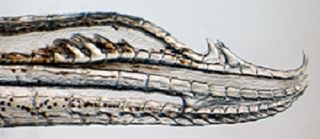Yikes! This Fish Sports a Penis With 4 Hooks

A male fish from Mexico has some fearsome genitalia. Equipped with four hooks, the male's sex parts might allow him to grab onto a resistant female during mating, researchers say.
The freshwater llanos mosquitofish, or Gambusia quadruncus, was described this month in the Journal of Fish Biology by a team led by researcher Brian Langerhans of North Carolina State University. Langerhans explained that the male's hooked genitals may be a counter-response to the female's own defenses against undesirable mates.
"Typically, reproduction is more costly in females, so females favor ways of reducing mating with 'lower quality' males, but reproduction is cheap in males and so selection favors ways of mating with as many females as possible," Langerhans said in a statement.
Females of this species have evolved to have a big ball of tissue that blocks most of the genital pore. This means the female would have to deliberately allow the male to mate with her unless the male evolved a counter-response, Langerhans explained. The four-hooked genitalia could help the males overcome resistance and latch onto a female's genital pore and deposit sperm inside her. (Fertilization in the Gambusia genus takes place inside the female's body and she gives birth to live young.)

Strange as it seems, such hooks aren't unheard of. Another new species (Phallostethus cuulong) that was recently discovered in Vietnam sports sex parts that jut out of its head and are equipped with a rod and a jagged hook to clasp the female during mating. The researchers who described that fish in a July edition of the journal Zootaxa similarly said hooking onto his mate probably helps ensure the male's fertilization success. [Image Gallery: Weird 'Penis Head' Fish]
Langerhans also described another strange feature in the llanos mosquitofish. The females have a colorful spot on their anus that seems to indicate the location of the female's genital pore, reproductive status, and species. The latter could reduce cross-breeding, Langerhans said.
"So it may be that G. quadruncus evolved different anal spots to help reduce interspecies matings and possible formation of hybrids," he said in a statement.
Sign up for the Live Science daily newsletter now
Get the world’s most fascinating discoveries delivered straight to your inbox.
Follow LiveScience on Twitter @livescience. We're also on Facebook & Google+.

Most Popular

